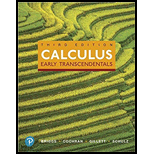
Average and marginal profit Let C(x) represent the cost of producing x items and p(x) be the sale price per item if x items are sold. The profit P(x) of selling x items is P(x) = x p(x) − C(x) (revenue minus costs). The average profit per item when x items are sold is P(x)/x and the marginal profit is dP/dx. The marginal profit approximates the profit obtained by selling one more item given that x items have already been sold. Consider the following cost functions C and price functions p.
- a. Find the profit function P.
- b. Find the average profit function and marginal profit function.
- c. Find the average profit and marginal profit if x = a units are sold.
- d. Interpret the meaning of the values obtained in part (c).
40. C(x) = −0.04x2 + 100x + 800, p(x) = 200 − 0.1x, a = 1000
Want to see the full answer?
Check out a sample textbook solution
Chapter 3 Solutions
CALCULUS:EARLY TRANSCENDENTALS-PACKAGE
Additional Math Textbook Solutions
Basic Business Statistics, Student Value Edition
Elementary Statistics: Picturing the World (7th Edition)
Elementary Statistics
College Algebra with Modeling & Visualization (5th Edition)
Elementary Statistics (13th Edition)
- Find the length of the following curve. 3 1 2 N x= 3 -y from y 6 to y=9arrow_forward3 4/3 3213 + 8 for 1 ≤x≤8. Find the length of the curve y=xarrow_forwardGiven that the outward flux of a vector field through the sphere of radius r centered at the origin is 5(1 cos(2r)) sin(r), and D is the value of the divergence of the vector field at the origin, the value of sin (2D) is -0.998 0.616 0.963 0.486 0.835 -0.070 -0.668 -0.129arrow_forward
- 10 The hypotenuse of a right triangle has one end at the origin and one end on the curve y = Express the area of the triangle as a function of x. A(x) =arrow_forwardIn Problems 17-26, solve the initial value problem. 17. dy = (1+ y²) tan x, y(0) = √√3arrow_forwardcould you explain this as well as disproving each wrong optionarrow_forward
- could you please show the computation of this by wiresarrow_forward4 Consider f(x) periodic function with period 2, coinciding with (x) = -x on the interval [,0) and being the null function on the interval [0,7). The Fourier series of f: (A) does not converge in quadratic norm to f(x) on [−π,π] (B) is pointwise convergent to f(x) for every x = R П (C) is in the form - 4 ∞ +Σ ak cos(kx) + bk sin(kx), ak ‡0, bk ‡0 k=1 (D) is in the form ak cos(kx) + bk sin(kx), ak 0, bk 0 k=1arrow_forwardSolve the equation.arrow_forward
- could you explain this pleasearrow_forwardthe answer is C, could you show me how to do itarrow_forward7. [-/1 Points] DETAILS MY NOTES SESSCALCET2 6.1.505.XP. Evaluate the integral. (Use C for the constant of integration.) 21z³e² dz | 21 Need Help? Read It SUBMIT ANSWER 8. [-/1 Points] DETAILS MY NOTES SESSCALCET2 6.1.020. Evaluate the integral. 36 In y dy ₤36 25 Need Help? Read It SUBMIT ANSWER 9. [-/1 Points] DETAILS MY NOTES SESSCALCET2 6.1.009. Evaluate the integral. (Use C for the constant of integration.) In(7x In(7x + 1) dxarrow_forward
 College AlgebraAlgebraISBN:9781305115545Author:James Stewart, Lothar Redlin, Saleem WatsonPublisher:Cengage Learning
College AlgebraAlgebraISBN:9781305115545Author:James Stewart, Lothar Redlin, Saleem WatsonPublisher:Cengage Learning Algebra and Trigonometry (MindTap Course List)AlgebraISBN:9781305071742Author:James Stewart, Lothar Redlin, Saleem WatsonPublisher:Cengage LearningAlgebra & Trigonometry with Analytic GeometryAlgebraISBN:9781133382119Author:SwokowskiPublisher:Cengage
Algebra and Trigonometry (MindTap Course List)AlgebraISBN:9781305071742Author:James Stewart, Lothar Redlin, Saleem WatsonPublisher:Cengage LearningAlgebra & Trigonometry with Analytic GeometryAlgebraISBN:9781133382119Author:SwokowskiPublisher:Cengage
 Trigonometry (MindTap Course List)TrigonometryISBN:9781337278461Author:Ron LarsonPublisher:Cengage Learning
Trigonometry (MindTap Course List)TrigonometryISBN:9781337278461Author:Ron LarsonPublisher:Cengage Learning





